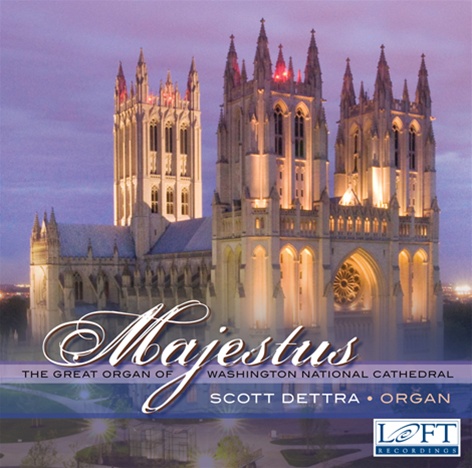Program Notes
Fanfare for the Common Man—Aaron Copland (1900–1990)
Aaron Copland’s Fanfare for the Common Man was one of several fanfares commissioned by the Cincinnati Symphony Orchestra to open its concerts during the 1942–43 season. The United States had recently entered World War II, and conductor Eugene Goossens hoped these pieces would foster patriotic spirit. Typical of Copland’s music, the piece uses open intervals and broad melodies to capture a uniquely American spirit that is at once rugged, optimistic, and heroic. Fanfare for the Common Man is often performed at the National Cathedral, most notably as the opening piece of the annual Independence Day organ recital. It provides an excellent opportunity to feature the two crowning stops on the Great Organ – the Trompette-en-Chamade and Tuba Mirabilis.
Prelude & Fugue in B major, Op. 7, No. 1—Marcel Dupré (1886–1971)
Marcel Dupré’s Trois préludes et fugues, composed in 1912, are among his most popular compositions for the organ. The first, in B major, is the most exuberant of the three, opening with a brilliant, toccata-like prelude. The busy fugue theme emerges naturally from the prelude and dances its way to a thrilling finish. This piece has been used as the closing voluntary for a number of major services at the cathedral in recent years, including the Inaugural Prayer Service for President Barack Obama in 2009.
Prière, Op. 20—César Franck (1822–1890)
Although he composed only twelve major works for the organ, César Franck is widely considered to be among the finest composers of music for the instrument. Greatly influenced by the innovative work of Aristide Cavaillé-Coll—the master organ builder of 19th-century France—Franck’s music laid the foundation for the great French organ symphonies of Charles-Marie Widor, Louis Vierne, and Marcel Dupré. Completed in 1863, the Prière is an extremely profound and devout work, with two lyrical themes accompanied by rich, five-part counterpoint. It is played almost entirely on warm 8’ foundation stops, which are bathed in the cathedral’s generous five-second reverberation.
Passacaglia, Op. 40—Seth Bingham (1882–1972)
Seth Bingham had a distinguished career as a church musician, composer, and teacher in New York City, serving as organist of Madison Avenue Presbyterian Church and on the faculties of Columbia University and Union Theological Seminary. Although he was a prolific composer, most of his music is rarely performed today. One of the little-known gems of his output, the Passacaglia is based on a haunting eight-measure theme which lends itself to a vast amount of harmonic variation. The twenty-eight variations explore the full tonal palette and dynamic range of the Great Organ.
Rhapsody in C-sharp minor, Op. 17, No. 3—Herbert Howells (1892–1983)
Herbert Howells is the quintessential composer of 20th-century English cathedral music. His choral and organ music is inextricably linked to the magnificent architecture and acoustics of the great English cathedrals and college chapels. The last in a set of Three Rhapsodies published in 1918, this piece was composed during a single, sleepless night during World War I. Howells was visiting Edward Bairstow (organist of York Minster) and was kept awake by the noise of Zeppelin raids. The anxiety of that experience can be heard in the piece’s highly chromatic opening section. A serene middle section builds to an intense climax and the piece closes with a long and dramatic crescendo to a final C-sharp major chord.
Adagio for Strings, Op. 11—Samuel Barber (1910–1981, )arr. William Strickland (1914–1991)
Easily his most famous composition, Samuel Barber’s Adagio for Strings began life in 1936 as the middle movement of a string quartet. Arturo Toscanini performed the work with the NBC Symphony Orchestra in 1938, and it has been hugely popular ever since. The Great Organ’s twenty-five ranks of celestes are a hallmark of its sound and are featured prominently in this piece.
Crown Imperial—William Walton (1902–1983, arr. Herbert Murrill (1909–1952)
William Walton was a versatile composer, equally at home writing music for the church, stage, concert hall, film, and ceremonial occasions. Composed for the coronation of King George VI in 1937, Crown Imperial is a grand march reminiscent of Edward Elgar’s Pomp and Circumstance marches. The Great Organ’s two high-pressure reeds are once again featured in this piece, including a magnificent coda played mostly on the Trompette-en-Chamade.
Introduction, Passacaglia, & Fugue, Op. 149—Healey Willan (1880–1968)
Although born in England, Healey Willan spent most of his career in Canada and is considered to be among that country’s finest composers. From 1921 until his death, e was organist of The Church of St. Mary Magdalene, Toronto, during which time he wrote hundreds of organ and choral works for church use. Introduction, Passacaglia, and Fugue, composed in 1916, is his magnum opus for the organ. The dark and weighty Introduction gives way to a colorful Passacaglia whose eighteen variations show off many of the orchestral colors of the organ. The Fugue starts quietly but builds to an intense climax before a grand coda puts appropriate punctuation on the end of this masterwork. Few pieces in the repertoire showcase the full capabilities of the Great Organ better than this one.


No comments:
Post a Comment